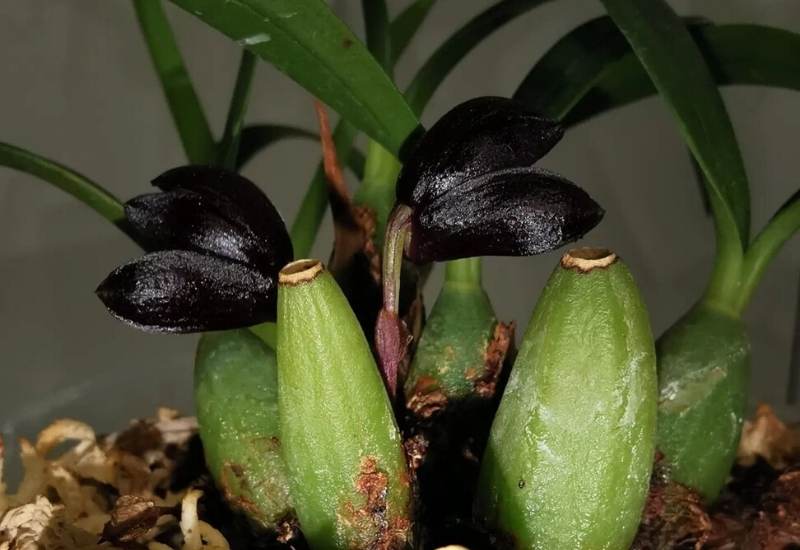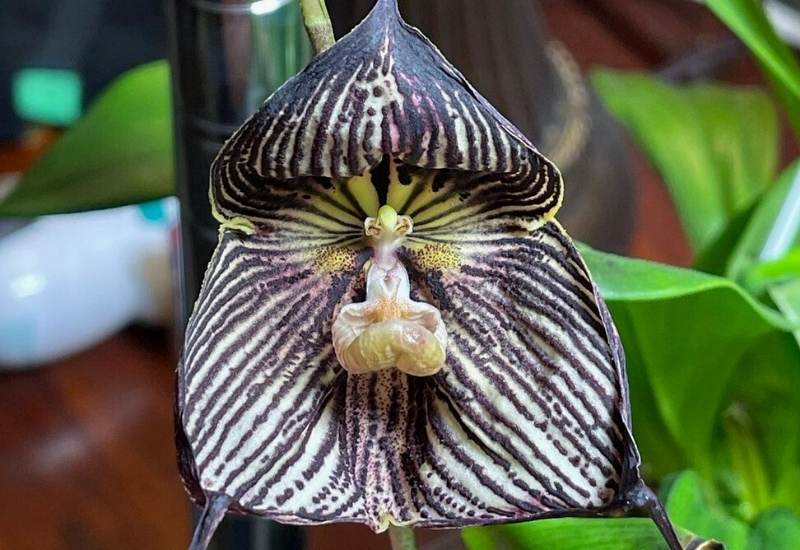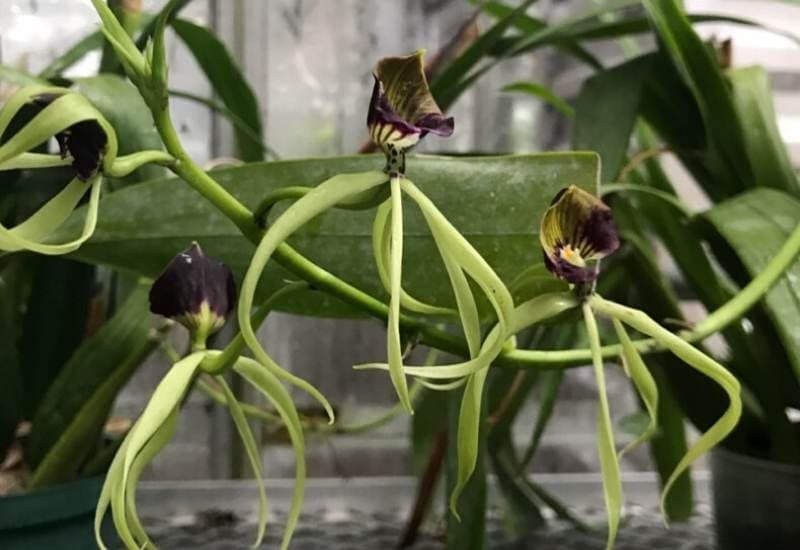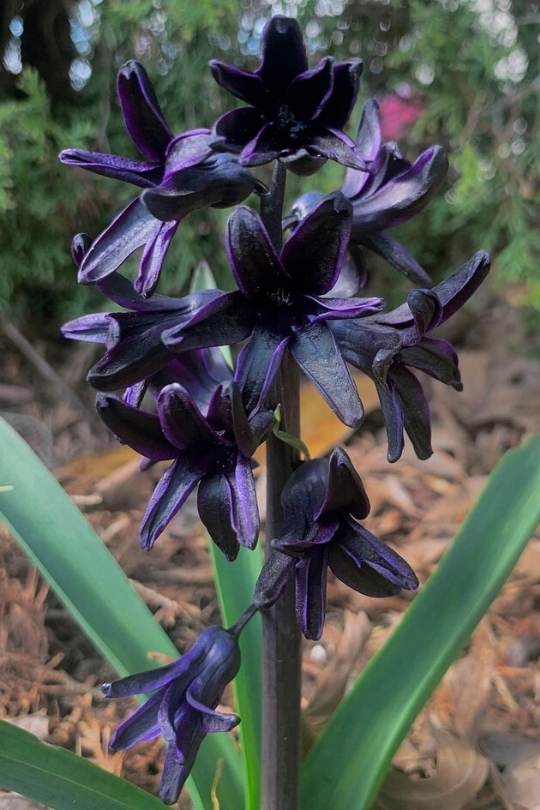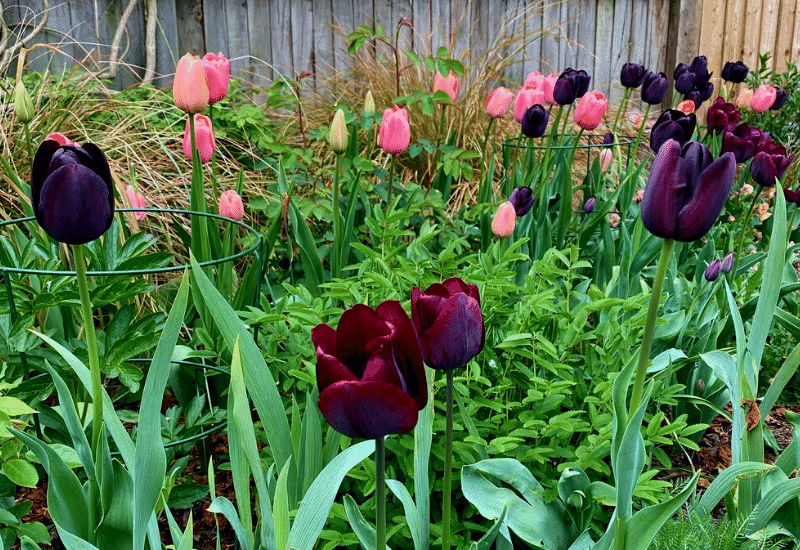
In the huge family of flowers, there are colors that are much more common than others, such as yellow and all shades of red, even green blooms are much more common.
But natural black flowers are really rare indeed, in fact, it may be so rare that it does not exist at all.
Black flowers are rare enough to convey a mysterious image matched only by their stunning beauty, especially if they are natural and not selected through breeding or hybridized by gardening professionals, and some may even end up costing a fortune.
In facto you actually know any real black flower?
Even if absolute black does not exist among the flowers; but there are some whose petals are so dark that they appear black to the inexperienced eye.
It would be more correct to call them “near black”, as in reality they are dark purple, dark blue and very intense violet, but not the actual color of pitch.
Dahlias, calla lilies, pansies, primroses, petunias, cosmos, roses, irises, tulips, hollyhocks, violas, lilies, and geraniums all have some varieties that appear black or nearly black blossoms.
In this article I’ll introduce you to the most beautiful flowers with dark-hued blooms and give you tips on how to use this striking “dot of color” effective in combination with brightly colored flowering plants.
You won’t find a better list of flowers that really look black than this, but how do pants produce this unusual color? I’m going to tell you right now!
The Color “Black” In Flowers And The Limits Set By Nature
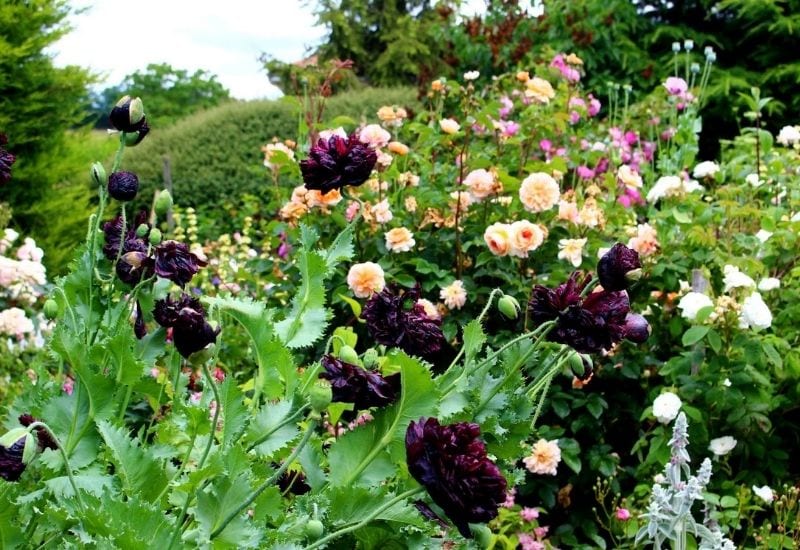
Still, wonder how Nature came up with flowers so dark that they look black?
As we said, there are no real black flowers in Nature. And you may wonder, are there hybrids or cultivars, or human bred varieties of this color? The answer is simply a resounding no.
In a way, all the efforts to get the “black tulip” or “black rose” are destined to fail. There is a scientific reason for this, and we are going to see right now.
Where Do the Colors of Plants Come From?
When we look at flowers, we can see that they can produce an infinite range of colors, but how do they manage that?
They are like painters; they “mix colors” on the palette to achieve all different mixes and shades, but they start from a limited range of colors.
Like color printers, in the end, they select precise quantities of each color to give us that impressive array we see before our eyes.
To be honest, they also have many colors that we cannot see, but bees and other animals do. In fact, scientists also say that there is no white flower in reality.
But let’s stick to black… We call these basic colors “pigments”.
What Is a Pigment in a Flower or Plant?
A pigment is simply a molecule, and each has a specific color. The most famous one is chlorophyll, which is green of course, and which plants use for photosynthesis.
This makes the leaves green, but then again, not all leaves are green. And even petals are modified leaves…
The reality is that plants use a series of pigments, and not just chlorophyll.
The Main Groups of Plant Pigments
Plants use many specific pigments, but they are divided into three main types:
Why Black Is Impossible to Achieve
You can simply mix all these colors as much as you want that you will never achieve black. It is just mathematically impossible… So, why do we call some flowers “black”?
Black Flowers Are Really “Near Black”
What can happen, is that you mix dark shades of pigments, especially in the blue and purple range, and you get a colors so dark that it appears almost black. So, what you need a lot of to reach this effect is anthocyanins…
The problem is also that anthocyanins are water soluble, and they depend on the acidity of the soil… This explains why the color “black” in bred varieties of flowers is very unstable…
Natural Black Flowers Vs. Human Bred Black Flowers
Who wins? Hands down the victory goes to Mother Nature… The darkest flower in the world is a natural one, and it’s waiting for you… Breeders have tried to hybridize plants for centuries to achieve this color, but…
Let’s take a famous example…
How many have claimed to have bred the black tulip? You buy the bulbs, and if you are lucky, the first year you get something that resembles black, if the soil is ideal.
Next year it will be purple or brown, and from there, it will keep losing color.
You see, natural black flowers have a far more stable color than those we breed and hybridize!
And this is why what’s coming up next is the list of the darkest flowers in the world!
The 18 Darkest, Blackest Flowers In Nature And Beyond
There aren’t many black flowers we can call black, and we have put them all together for you, spontaneous or human bred.
While black flowers used to only be found in a Gothic garden, today they are seen as a striking “dot of color” that is particularly effective in combination with brightly colored flowering plants.
Here are 18 hauntingly beautiful flowers with black blossoms to add elegant accents and exotic splashes of color in your garden.
1. Black Bat Flower (Tacca chantrieri)
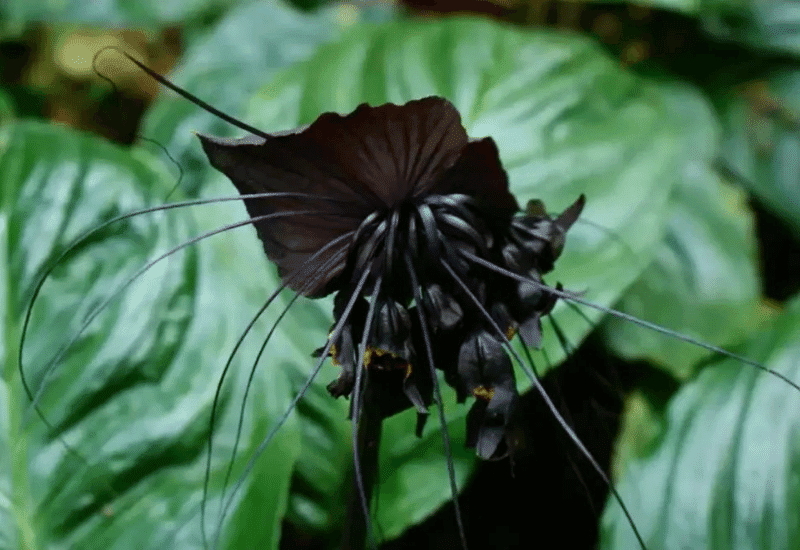
Black bat flower is very unusual and rare flowers in the world! This gothic beauty from South East Asia is so dark that it looks black, and it’s also shaped like a strange animal, like something you would expect to see in a movie like Alien.
It looks like a large open mouth with strange teeth inside and then another funnel shaped mouth inside of it…
Then it has kind of whiskers that fall to the sides… Ok, let’s call it a bat for simplicity’s sake…
They are actually massive flowers, 12 inches across (30 cm) and the whiskers can reach 28 inches long (more than 70 cm)!
So, it may well frighten you to find one in bloom in a rain forest. The color is not always very black though, it really depends on the soil and growing conditions.
2. Black Hellebore (Helleborus niger)
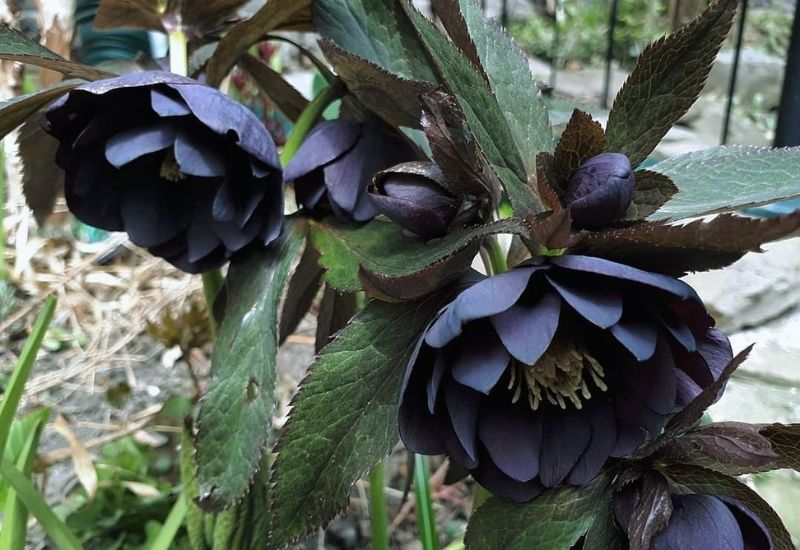
Hellebore, a.k.a. Christmas rose is one of the flowers with the widest and most sophisticated palette in the world, in fact it goes from snow white to almost black. The actual color is a very dark purple blue which almost looks metallic.
Of course hybrids have been developed to extoll and enhance the darkness of this amazing perennial, like ‘Kissi Royal Maroon’ and Helleborus x hybridus ‘Garden Black’ and the cultivars ‘New York Nights’ and ‘Onyx Odyssey’.
It is also a winter bloomer, which makes it absolutely unique and precious for gardeners.
You can grow black hellebore very easily; it’s an undemanding plant which naturalizes perfectly and it looks great in borders, beds and even under trees, because it is also a shade loving plant.
3. Black Aspidistra (Aspidistra astrata)
Black aspidistria is a recent discovery in the botanical world; it was identified for the very first time in 2011 by an expedition in Vietnam.
The flowers are a wonder of Mother Nature! The cup shaped blooms are almost pure black, with ten petals attached at the base and a purple center with stamens and pistil.
They are also fairly large, about 2 to 3 inches in diameter (5 to 7.5 cm). The leaves are beautiful too, long and green and coming straight from the floor, where it hides a rhizome.
Unfortunately, you won’t be able to grow black aspidistria in your garden, as it is not on the market… But who knows, if you are patient, maybe in the future…
4. Black Calla Lily (Arum palaestinum)
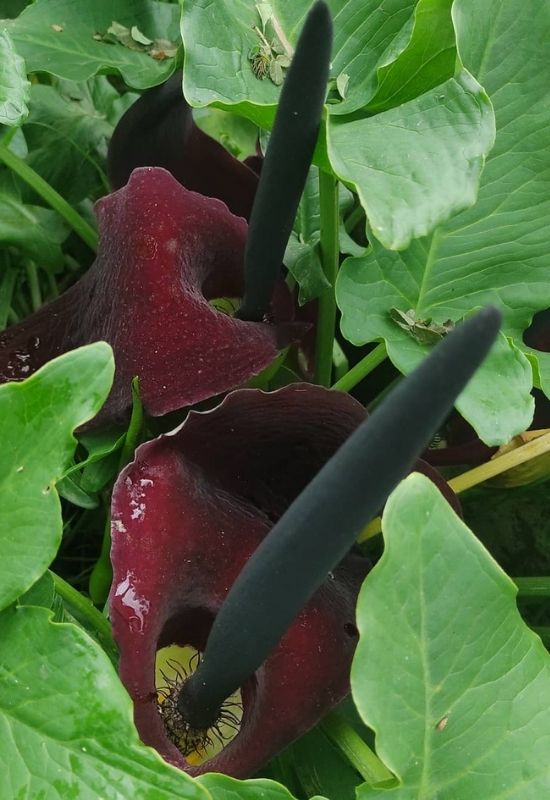
Also known as Zantedeschia, noo’ah’s hoof and Solomons’s lily, this herbaceous perennial has a spathe, like its relatives peace lily, but the outside is green, while the inside is almost black. And the spadix too is of this extreme color.
So we can call it a “natural black flower”. It is actually of a very dark purple shade, and this contrasts very well with the glossy, emerald green and sagittate leaves. After the bloom, it will also produce a cluster of berries.
The leaves can be eaten, but they need to be leached because they are toxic, even in slow doses. It is original of the Middle East where it is cultivated for food and medicine.
5. Black Pansy (Viola spp.)
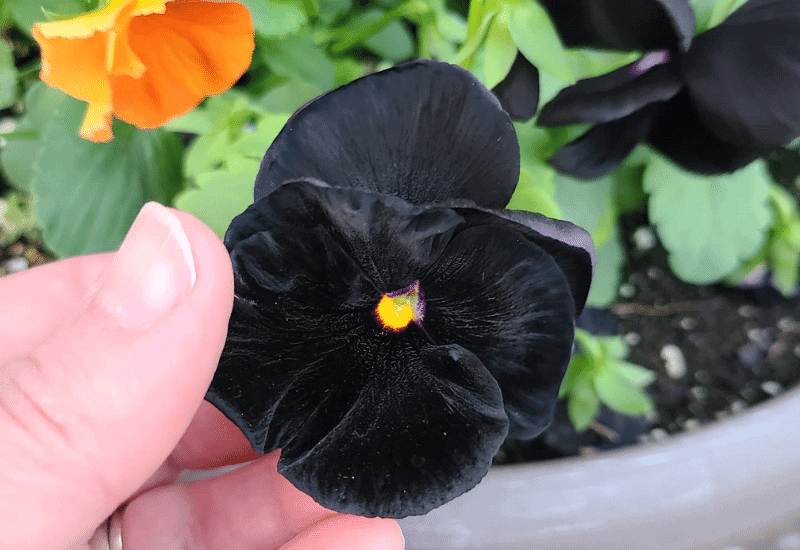
Pansies are famous for their colorful flowers and they have some special qualities: they have an amazing range of colors and they can produce loads, but really loads of anthocyanins!
In particular, Viola is a rare species that has both purple and blue in its genes… And these are the pigments that give us very dark, almost black shades.
In acidic soils in particular, they naturally turn parts of the petals very dark purple, so we can put them among the natural flowers with this exceptional tint. We will look at hybrids and cultivars later on, because there are some amazing beauties!
Pansies are great in flower beds and containers; they are good for formal and informal gardens. And remember that they are perennials, so if you live in a fairly warm country, don’t root them up at the end of the season!
6. Black hollyhocks (Alcea rosea)
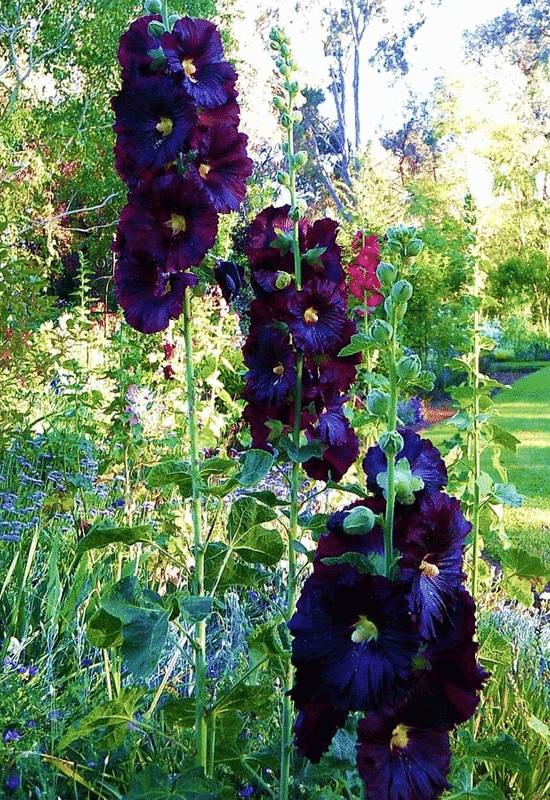
Hollyhock too can produce lots of anthocyanins, so it can occasionally have very dark shades, bordering black. This is a natural development of the purple range, and it happens when this herbaceous plant adapts to the growing conditions, especially the soil, but also the light.
So the long spikes of dark flowers can add a touch of unexpected beauty to your garden, and they can even surprise your visitors with their rare chromatic expression.
Hollyhock is ideal for natural looking borders or large beds, especially loved in cottage gardens and English country gardens. It looks great also in countryside settings.
7. Schunke’s Maxillaria Orchid (Brasiliorchis schunkeana)
Schunke’s maxillaria is a small but spectacular type of orchid and one of the darkest flowers in nature. The flower is in fact so black that it looks like the “real thing”.
The blooms are small, 2/5th of an inch in diameter (1 cm), fleshy and very waxy, so you get an impressive effect with the reflected light.
The leaves are broad, oval and glossy too, light green in color, and the blossoms will appear towards the base of the foliage, where the plant has characteristic pseudobulbs.
But you are in luck, there are cultivars like ‘Sunblast’, ‘Hickory Wind’ and ‘Hanging’ that have been developed in recent years, so you can even grow one! In a pot or container, of course!
8. Vampire Orchid (Dracula vampira)
Vampire orchid is yet another natural beauty with a gothic touch! It has three pointed petals (tepals) with yellow green and almost black stripes running along them while the labellum is central and with white and golden yellow stripes.
The whole flower is actually large, as each petal, with the “tail” can be up to 5 inches long (12 cm)!
The leaves are emerald green, veined and very glossy indeed. This epiphyte is unfortunately on the endangered species list, classed as “vulnerable”; let’s hope future generations will be able to admire it too.
I have checked it out for you…
You can grow this rare plant, so you can even help with the conservation of a very unusual species of orchid, but make sure you take it as a responsibility too.
9. Black Iris (Iris nigricans) and Judean Iris (Iris atrofusca)
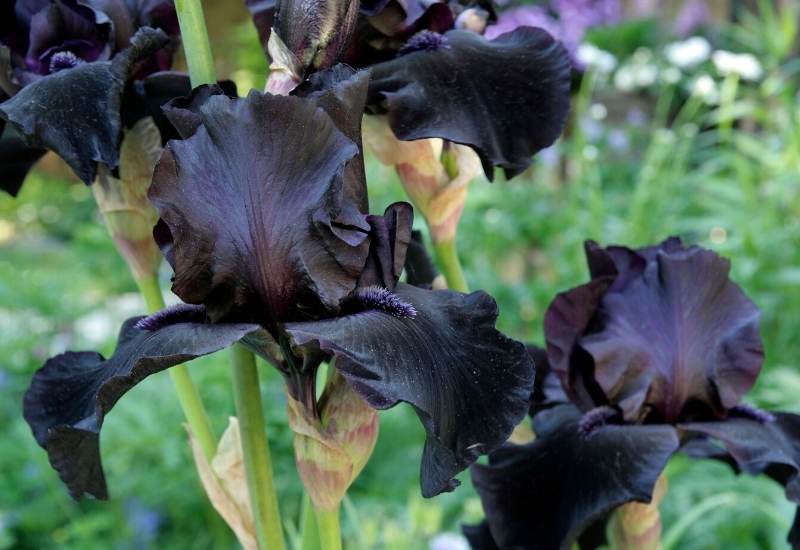
Iris is yet another genus of flowers with a very strong and intense purple range, and the national flower of Jordan, Iris nigricans, is almost black.
The flowers are very large indeed, up to 6 inches in diameter (15 cm) and of a very dark violet purple shade.
This makes a lovely mid to dark emerald green foliage. It grows spontaneously among rocky soil with another species, Judean iris, (Iris atrofusca) which is called “black” and has showy dark purple blooms too.
Unfortunately, Iris nigricans is endangered, while Iris atrofusca is “near threatened” and a fairly rare sight even in its natural habitat.
10. Clamshell Orchid (Prosthechea colchleata)
Clamshell orchid is the national flower of Belize, in fact it is also known as the “black orchid of Belize”. It is not fully black, in fact the lower petals (tepals) are long, thin, green and they curl like wood shavings.
The upper tepal is large and rounded, and it has very dark purple and cream stripes.
The whole flower is about 3 inches wide (7.5 cm). But this orchid also has a strange characteristic. The “hood” (upper tepal) is actually the labellum, which in other orchids is at the bottom of the flower head. So, it is also an “upside down orchid”!
It’s a very colorful flowers, despite the very dark stripes it displays, and this makes it ideal for its dramatic and architectural qualities.
Human Bred Black Flowers (Hybrids And Cultivars)
“Are there any other black flowers in Nature?” you may ask… Well, it depends on “how black” you want them… most of the other flowers are visibly dark purple, and not convincingly black.
Are there any fully black human bred flowers? No, they too are dark purple, but breeders can achieve darker shades than some natural species obtain by selecting (cultivar) very dark specimens, or interbreeding species with this property (hybrids).
We must say that “human bred” does not mean “unnatural”; the genes are fully natural in fact, breeders, botanists and gardeners have only lent a helping hand to Mother Nature. So they are “enhanced natural black flowers” we are talking about.
But are they as good as “fully natural” ones? The color may be even closer to black in many cases, but…
Future generations will lose it, and fast, unlike spontaneous varieties. This is especially true if you reproduce them by seed.
And as we said, the actual shade will lighten up with years in many cases, and soil conditions still matter. But they are often easier to get and grow.
But if you want some of the color of night in your garden, there are hybrids and cultivars too.
So, as a bonus, here are the very darkest of them all!
11. ‘Queen of the Night’ Tulip (Tulipa ‘Queen of the Night’)
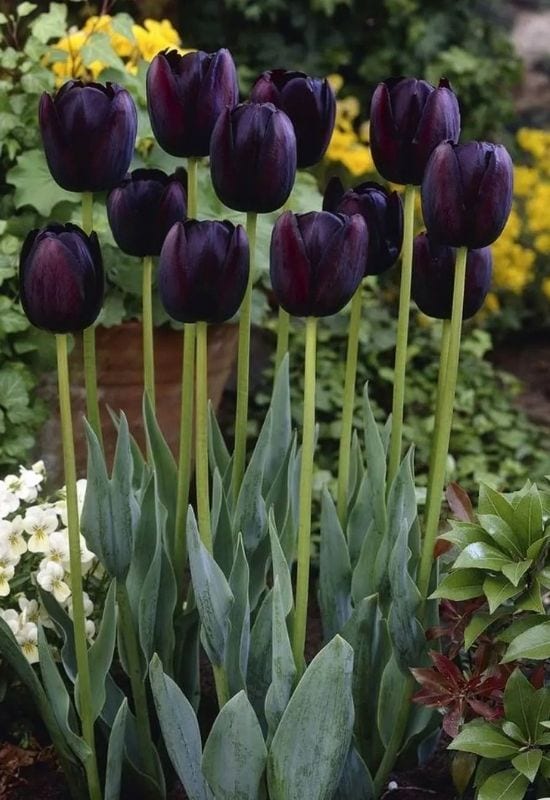
‘Queen of the Night’ is the black tulip. Fruit of hundreds of years of efforts, and by far one of the most legendary black flowers in the world, no wonder it is one of the most sought after tulips ever.
It is a late and single blooming variety, with very dark purple blooms, cupped and single.
It will keep vigorous for many years, coming back every spring, but the color may fade over time, and it also depends on soil conditions.
It’s no surprise that it is a e of the Award of Garden Merit by the Royal Horticultural Society…
‘Queen of the Night’ is an eye catching addition to flower beds and containers, and it can also work in formal settings.
Do remember to uproot the bulbs after the leaves have withered and keep them in a cold, dark and especially dry place till you can plant them in October.
12. ‘Black Pearl’ Asiatic Lily (Lilium asiaticum ‘Black Pearl’)
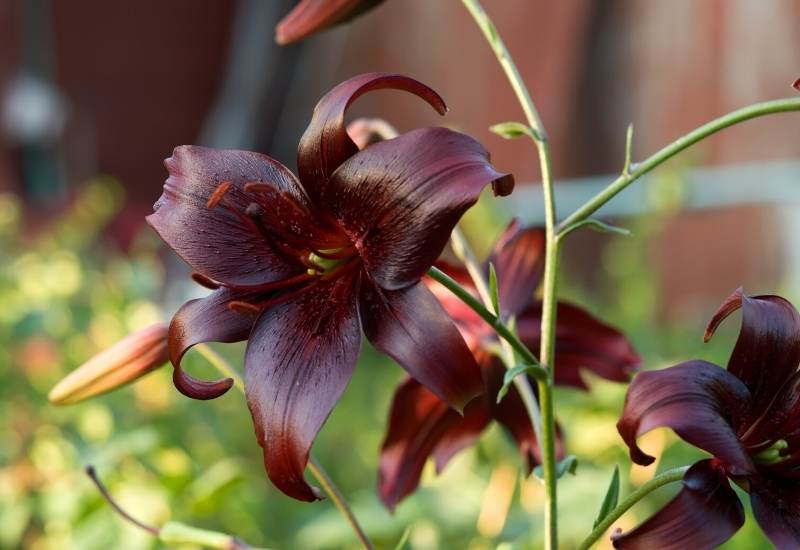
‘Black Pearl’ is a very showy, large bloomed Asiatic lily cultivar with a very dark purple shade, and each bulb can produce up to 15 flower heads. These can be 8 inches across (20 cm) and they have yellow or golden orange anthers inside.
It is a fragrant plant, but many think its aroma is unfortunate, not butterflies though, that simply love to hover above these beautiful exotic looking blossoms.
‘Black Pearl’ is a comparatively easy variety of lily to grow in flower beds and even in borders, but do remember that the bulbs are delicate, they need overwintering in a cool and dry place, and they need very loose soil to grow properly and store energy for next year.
13. ‘Before the Storm’ Bearded Iris (Iris germanica ‘Before the Storm’)
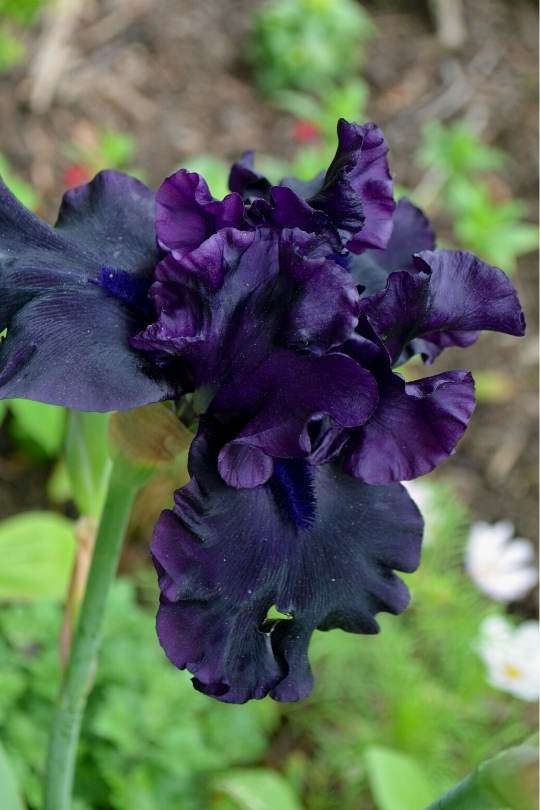
‘Before the Storm’ is very dark purple variety of bearded iris which produces lots of bloom buds for a very long time, up to 12 for each stem.
It has won 4 major gardening awards since its introduction in 1989, and it is one of the most reliable black cultivar flowers ever!
Add that it is very easy to grow, very vigorous, easy to propagate and disease free, you get the perfect choice for a carefree garden with an unusual palette.
‘Before the Storm’ is ideal for most types of informal gardens in flower beds and borders and you can also grow it for cut flowers. It also adapts to coastal gardens very well.
14. ‘Odessa’ Black Calla Lily (Zanthedeschia ‘Odessa’)
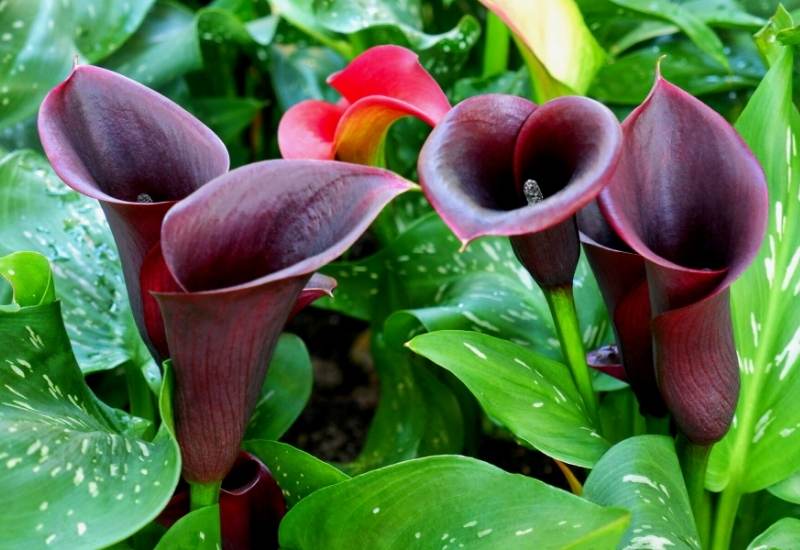
Odessa is the darkest canna lily you can find all over the world!
It has a very deep purple shade that almost looks black. The color is fairly stable too, so you can trust its gothic look, and enjoy its trumpet shaped flowers (spathes) when they open in the middle of mid green leaves adorned with light specks, fleshy and sagittate (arrow shaped).
The blooms may also a very long time, all the way into fall!
‘Odessa’ is a very elegant and sculptural black calla lily, suitable for beds, borders and containers in both formal and informal settings.
It is also low maintenance, vigorous and very strong indeed despite its exotic appearance.
15. ‘Black Moon’ Pansy (Viola x wittrockiana ‘Black Moon’)
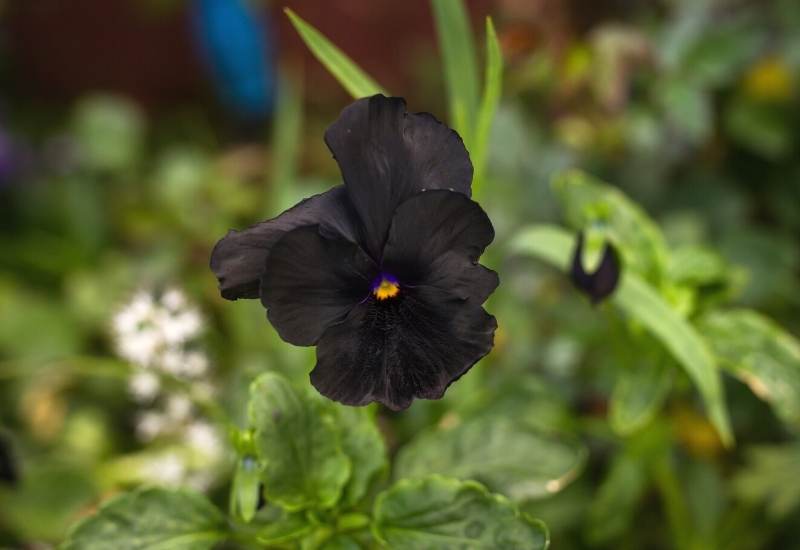
‘Black Moon’ is a recently introduced cultivar of pansies that has made headlines all over the world thanks to its amazing color: it is really hard to tell that it’s not pure black, and in fact many consider it the darkest bred flower of this color in the world!
It represents a massive achievement for breeders, and the golden yellow dot in the middle is like the icing on the cake of this extraordinary beauty!
For an incredible flower bed or containers that will literally wow your visitors, you can easily grow ‘Black Moon” from seed and it will blossom almost all year round! It is also fairly easy to find nowadays.
16. ‘Midnight Mystic’ and ‘Dark Dimension’ Hyacinth (Hyacinthus orientalis ‘Midnight Mystic’ and Hyacinthus orientalis ‘Black Dimension’)
‘Midnight Mystic’ and ‘Dark Dimension’ are two hyacinth cultivars with virtually black flowers.
One comes from a very dark blue shade, the other from an equally dark purple shade. They are really striking and sweet smelling, with the thick, sugary cluster of star shaped blooms you would expect in all other garden hyacinths.
This spring blossoming bulbs will certainly give a very original twist to your garden, with shades that no one would expect in this early season.
Both ‘Midnight Mystic’ and ‘Dark Dimension’ are excellent in flower beds and in containers, and you can also grow them hydroponically with good success.
They are delicate bulbs though, prone to disease and which need to spend the summer months in a cool, dark and dry place. If you leave them in the ground, you will almost certainly lose them.
17. ‘Black Cat’ Petunia (Petunia ‘Black Cat’)
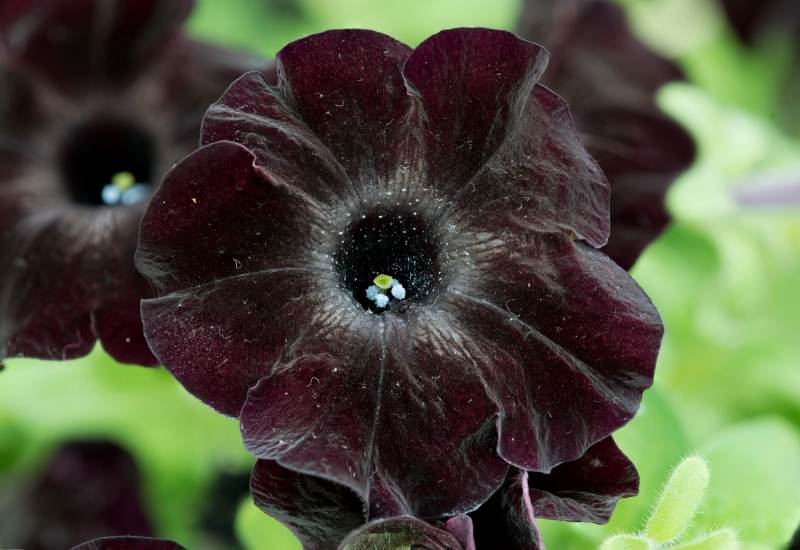
‘Black Cat’ is a recent addition to the Petunia genus, and, as the name suggests, it is of the color of pitch…
It actually is very, very dark and hard to tell with the naked eye that this flower is indeed dark purple.
This is yet another impressive breeding achievement, and it is due to the amazing natural range of colors, including blue and purple of this champion bloomer!
It will give you an impressive bloom with innumerable flower heads all year round, and it can do it a second year too!
Easy to grow and low maintenance, ‘Black Cat’ is set to become a hit among amateur gardeners all over the world.
So, get in there soon and order some seeds; it is ideal for hanging baskets, but also for flower beds and rock gardens! And trust it, it won’t let you down…
18. ‘Blackout’ Violet (Viola cornuta ‘Blackout’)
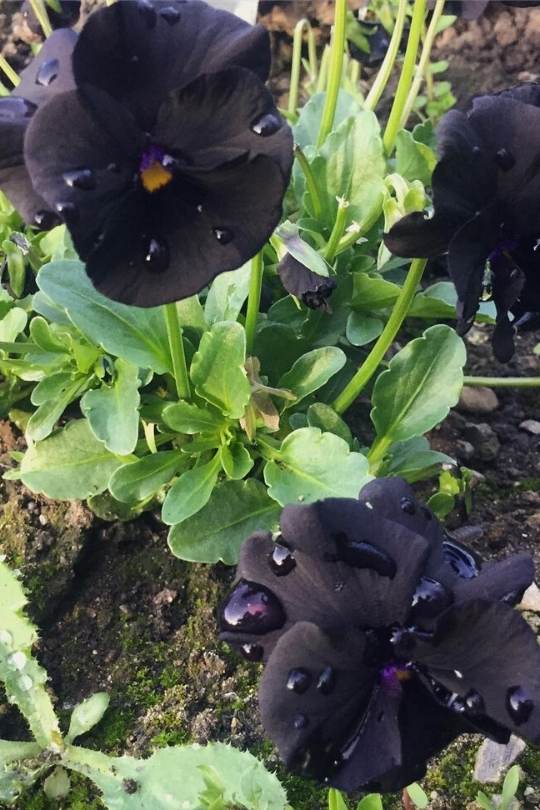
‘Blackout’ is a unique horned violet with almost black petals with a tiny violet blue and golden yellow center.
The overall effect is impressive, and the little flowers are abundant throughout the warm season above the delicate mid green foliage.
They will form beautiful clumps of unusual beauty, as the petals are very velvety, which goes perfectly well with the sark shade they have.
You will notice an undertone of violet purple in the blooms, depending on the light effects but also on the quality of the soil and sunlight exposure. Did I mention that the flowers a also fragrant, as well as edible?
‘Blackout’ can be a very original choice as ground cover even under trees and in naturalized areas.
Alternatively, you can grow it in containers or flower beds, where you can naturalize it fairly easily, and it will still give you a spectacle like no other.
Or just imagine a rock garden with colored stones and black violets… Yes, you can literally work “the other way round” with this plant… Its shade also makes it suitable for city and especially courtyard garden.
Black: The Most Unusual Color In Flowers, Natural And Bred
I know I left you with a question: is there a black rose? I am sorry to disappoint you, but I wouldn’t not really call it “black”. The darkest rose is a deep red purple shade, with no real hint at the color of the night…
Nor do I think it will ever be bred; you see, you need both blue and purple to get a near black color, and roses do not have blue on their palette.
But these are virtually all the black flowers you can find, some fully natural, and striking indeed, but hard to grow, with few exceptions; then there are some cultivars and hybrids, striking as well, and these are easy to find and even grow in some cases.
So, whether you came here out of sheer curiosity or because you want this amazing color in your garden, you know your choice, and you know that there are wonderful “gothic beauties” out there waiting for you!

Written By
Amber Noyes
Amber Noyes was born and raised in a suburban California town, San Mateo. She holds a master’s degree in horticulture from the University of California as well as a BS in Biology from the University of San Francisco. With experience working on an organic farm, water conservation research, farmers’ markets, and plant nursery, she understands what makes plants thrive and how we can better understand the connection between microclimate and plant health. When she’s not on the land, Amber loves informing people of new ideas/things related to gardening, especially organic gardening, houseplants, and growing plants in a small space.

